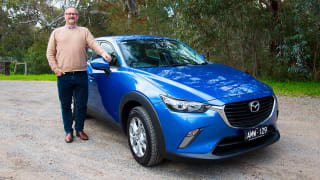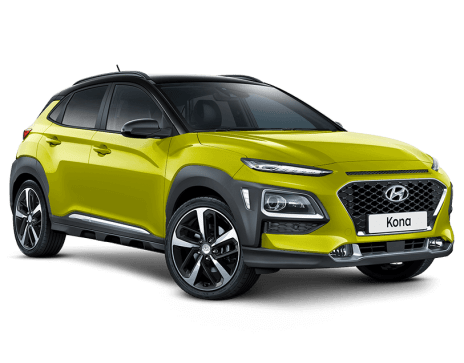
Mazda CX-3 2017 review
One of Mazda's biggest successes of recent years is the diminutive CX-3, which launched to a rapturous reception in 2015. Will the 2017 update boost it further?
Browse over 9,000 car reviews
It's easier to figure out the deepest and darkest mysteries of the universe (the answer, by the way, is 42) than it is to work out what mysterious ingredients are needed to successfully launch a car into the booming small SUV segment.
One of Australia's most crowded vehicle categories is also its most diverse. There are big ones, small ones, practical ones, ones that aren't really SUVs at all, ones that are really quite good and some that could only be less appealing if they arrived with factory-fitted mullets. And yet they all somehow compete under the catch-all banner of "small SUV", and most achieve some level of sales success.
Into this frantic fray launches the all-new Hyundai Kona, the Korean brand's first-ever entrant in this segment. And if you're wondering what they've been doing while all these other manufacturers have been making tiny SUV hay, you're not alone. And on that, we hand over to the brand's local boss, JW Lee.
"We're a bit late to the small SUV market, we must admit, but not too late," he says. "On the flip-side, we've been able to observe the market closely, and study our competitors, and bring something great to the SUV segment."
We suspect that the whole "studied our competitors" thing is meant quite literally, which is why the Kona looks a bit like a Subaru XV, is roughly the size of the Mazda CX-3 and apes the practicality positives of the Honda HR-V.
But is Hyundai's smallest SUV the best of the bunch?
| Hyundai Kona 2017: Active Safety | |
|---|---|
| Safety rating | |
| Engine Type | 2.0L |
| Fuel Type | Regular Unleaded Petrol |
| Fuel Efficiency | 7.2L/100km |
| Seating | 5 seats |
| Price from | $20,460 |
Is water wet? Small SUVs seem to be the segment in which designers really let their hair down (we're looking at you, Toyota C-HR), and the Kona is another example of boundary-pushing design.
And by boundary-pushing, we mean it's both loved and loathed - but we're in the love it camp. As mentioned above, there's plenty of Subaru XV in there - from the plastic cladding that Hyundai calls armour to the vaguely wagon-shaped body - but there are also enough differences to ensure the Kona stands out from the pack.
Most notable, of course, is the new front face design, with thin-strip DRLs, separate headlight clusters and a reshaped grille all giving the little Kona a sporty, aggressive stance when viewed front on.
Inside, much has been done to make the small cabin seem bright and airy, and it all feels very well put together, but there are plenty of cheap-touch plastics covering the dash and doors, and a fairly sparse backseat that lacks air vents, power sources or USB connections - no matter how much you spend.

It is perhaps the first time - and certainly the first in recent memory - that the Hyundai isn't the price-leader in a segment. In fact, provided you're prepared to shift gears yourself and make do with an entertainment system that looks like the slit in Ned Kelly's helmet, you could find yourself in a Mazda CX-3 for about $4k less.
Instead, the Kona will arrive in four trim levels (the Active, Active with Safety Pack, Elite and Highlander), with each available with one of two engines and in two- or all-wheel drive.
The Active kicks off from $24,500 ($27k drive-away) in its cheapest guise and climbs to $28,000 for the better engine and all-wheel drive. Your investment buys you 16-inch alloys, LED daytime running lights and dusk-sensing headlights outside, while an Apple Car Play and Android Auto-equipped 7.0-inch touchscreen handles the entertainment.
Power windows in both rows, roof rails and cruise control also arrive as standard, joined by cloth seats and a leather-wrapped steering wheel and shift knob.
As the name suggests, the Active with Safety Pack ($26,000 - $29,500) adds Hyundai's SmartSense safety package, which includes blind-spot monitoring, rear cross-traffic alert, lane keeping assist, AEB with pedestrian detection, forward-collision warning and a driver-attention warning, as well as powered and heated wing mirrors.
The Elite model ($28,500 - $32,000) builds on all that with bigger 17-inch alloys, leather-appointed seats, push-button start and climate control, along with rain-sensing wipers, seat-back pockets and a luggage net.
Finally, the Highlander ($33,000 - $36,000) gets the biggest 18-inch alloy wheels, a head-up display, heated and cooled front seats, LED headlights with high-beam assist, a heated steering wheel and a wireless charging pad for your (compatible) phone.
At 4165mm in length, the Kona is shorter than both the Mazda CX-3 and Honda HR-V, but at 1800mm it is slightly wider than both, and clever use of the space inside means the backseat actually isn't too tough a place to spend a time.
Sitting behind my own (5ft 8inch) driving position, there was a little clear air between my knees and the seat in front, as well as above my head. The power controls for the rear doors do protrude into the window seats though, which would be an issue should you go three-across in the backseat. Which you won't. Because you're not a bad person.
Up front, there are two cupholders, as well as a single USB, Aux-in connection and power source, all of which sit in a little storage bin that's part of the central dash setup. There's another, deeper bin separating the front seats, too.
Two more cupholders live in the pulldown divider that splits the backseat, and there's an ISOFIX attachment point in each window seat. Each door has room for small bottles, too.
At 361 litres VDA, boot space is bigger than that in a CX-3 but smaller than in a HR-V, and that number grows to 1143 with the rear seat folded flat. A space-saver spare is housed in the boot.
Two on offer here, both petrol-powered, and each available in any of the Kona's trim levels.
The cheaper option is a 2.0-litre petrol unit good for 110kW at 6200rpm and 180Nm at 4500rpm, and will pair with a conventional six-speed torque converter automatic, sending its power to the front wheels.
Option two is a turbocharged 1.6-litre engine producing 130kW at 5500rpm and 265Nm at 1,500rpm. It pairs with a seven-speed dual-clutch automatic, and sends the grunt to all four wheels.
The less-powerful option is also the thirstiest, with the 2.0-litre engine sipping 7.2 litres per hundred kilometres on the claimed/combined cycle, and will emit 169g per kilometre of C02.
Opt for the turbo and your claimed/combined fuel use drops to 6.7 litres per 100km, while emissions fall to 153g per kilometre of C02.
Let's start with the 2.0-litre option, shall we? The numbers don't look all that pretty on paper, sure, but actually the 110kW and 180Nm on offer is pretty capable of pulling the Kona around. There is some harshness when you really bury your foot, though, and you can hear the engine straining, but around the city and its surrounds it does the job just fine.
That said, the turbocharged engine does offer more bang for your more bucks, and the extra torque on tap makes country driving a breeze, with quick overtakes no problem at all. The dual-clutch gearbox performed admirably, too, albeit after some slight stuttering when it was cold in the morning.
Like all Australian-delivered Hyundais, the Kona has been locally tuned, and they've done a stellar job here across the range. On really bad surfaces you can find the outer edges of the suspension, but generally speaking it does a great job of soaking up lumps and bumps while always feeling connected to the road below it.
Even more impressively, the little Kona actually feels genuinely dynamic, holding through corners with nary a wobble from the body. We'd want to drive them all back-to-back again to be sure, but if the Kona isn't the most dynamic-riding model in its segment, it's going to be damn close.
There are some slight annoyances though, and one is the general refinement. The naturally aspirated engine does get loud and raspy when you ask too much of it, and while the turbocharged unit is much better, it's still quite loud under hard acceleration. There's road noise in the cabin on the wrong surfaces, too (although its far more obvious on the smaller, 16-inch alloys).
They're minor things, though, and more generally speaking, the Kona is an easy, comfortable drive in or out of the city.
Basic Warranty
5 years / unlimited km warranty
ANCAP Safety Rating

If your budget extends only to the Active, expect six airbags, a rear-view camera, rear parking sensors, tyre-pressure monitoring, hill-start assist and downhill brake control, as well as the usual suite of traction and braking aids.
The Safety Pack adds safety (surprise!) including blind-spot monitoring, rear cross-traffic alert, lane-keeping assist, AEB with pedestrian detection, forward collision warning and a driver-attention warning.
Spring for the Elite and you'll add front fog lights, while the Highlander gets auto high beams and front parking sensors.
Like all Hyundais, expect a very good five-year, unlimited-kilometre warranty with service intervals pegged at 12 months or 15,000kms. Your first five services are capped, too, at a total $1395 for the 2.0-litre engine, and $1405 for the turbocharged option.
It might be late to the party, but we're tipping the Kona will make a hell of an entrance. Stylish, smart and easy to live with, it's sure to tick plenty of boxes.
For mine, though, the Kona range makes the most sense early in the model range. I think your money is better spent on the Active or Active with Safety Pack trims, with the higher grades a lot of cash to part with for what doesn't feel like a whole lot more car.
| Vehicle | Specs | Price* | |
|---|---|---|---|
| Active Safety | 2.0L, ULP, 6 SP AUTO | $20,460 – 25,850 | 2017 Hyundai Kona 2017 Active Safety Pricing and Specs |
| Active | 2.0L, ULP, 6 SP AUTO | $19,910 – 25,190 | 2017 Hyundai Kona 2017 Active Pricing and Specs |
| Launch Edition (awd) | 1.6L, ULP, 7 SP AUTO | $20,790 – 26,290 | 2017 Hyundai Kona 2017 Launch Edition (awd) Pricing and Specs |
| Active Safety (awd) | 1.6L, ULP, 7 SP AUTO | $19,690 – 24,970 | 2017 Hyundai Kona 2017 Active Safety (awd) Pricing and Specs |
| Design | 8 |
|---|---|
| Price and features | 7 |
| Practicality | 7 |
| Under the bonnet | 8 |
| Efficiency | 8 |
| Driving | 7 |
| Safety | 7 |
| Ownership | 8 |
$13,980
Lowest price, based on 133 car listings in the last 6 months